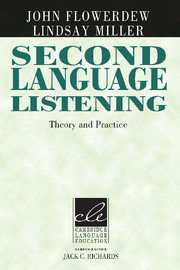Book contents
- Frontmatter
- Contents
- Series editor's preface
- Preface
- Acknowledgments
- Part I HISTORICAL BACKGROUND
- Part II A PEDAGOGICAL MODEL AND ITS APPLICATION
- 6 A Pedagogical Model for Second Language Listening
- 7 Materials and the Pedagogical Model for Listening
- 8 Case Studies and their Relation to the Pedagogical Model
- Part III KEY ISSUES IN TEACHING AND TESTING
- Appendix: Concluding Questions for Reflection
- References
- Index
7 - Materials and the Pedagogical Model for Listening
Published online by Cambridge University Press: 04 February 2010
- Frontmatter
- Contents
- Series editor's preface
- Preface
- Acknowledgments
- Part I HISTORICAL BACKGROUND
- Part II A PEDAGOGICAL MODEL AND ITS APPLICATION
- 6 A Pedagogical Model for Second Language Listening
- 7 Materials and the Pedagogical Model for Listening
- 8 Case Studies and their Relation to the Pedagogical Model
- Part III KEY ISSUES IN TEACHING AND TESTING
- Appendix: Concluding Questions for Reflection
- References
- Index
Summary
Introduction
In this chapter, we analyze listening material from a selection of textbooks. We describe how four English language textbooks, from beginner to advanced level, help learners develop their listening skills. After the brief descriptions, we apply the model described in Chapter 6 to see how the different dimensions are accommodated in the materials. We do this by way of tables. We highlight which dimensions of the model may be present in the material and describe the types of activities we found and which language and learning skill objective may be present. It is important to note, however, that we would not expect all the dimensions mentioned in our model to be present in each unit of a textbook, and so the purpose of applying the model is not to show deficiencies but only to illustrate which dimensions of the model are present. After the textbook analysis, we offer a checklist of questions that material writers might consider using when preparing listening materials. Then we show how one piece of material, specially prepared to assist students develop their listening skills, can be supplemented to take account of the new model and the different dimensions of listening.
Beginners
About the Book
On Target! (Holt 1999) is an integrated language skills book for young learners – 6 to 11 years old. The introduction to the teacher's guide describes the materials as having a “building-blocks” approach to the development of language where by content and skills are integrated. Students are encouraged to learn the language appropriate to performing certain tasks and activities, thereby making the language learning meaningful.
- Type
- Chapter
- Information
- Second Language ListeningTheory and Practice, pp. 98 - 123Publisher: Cambridge University PressPrint publication year: 2005



